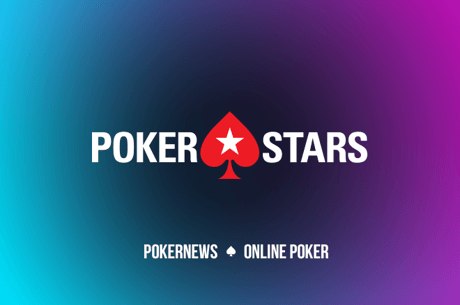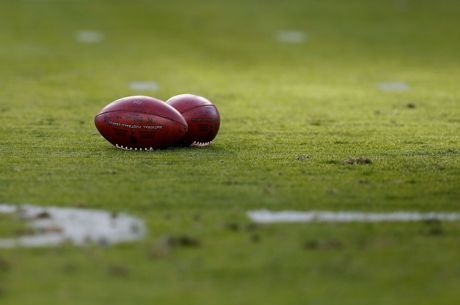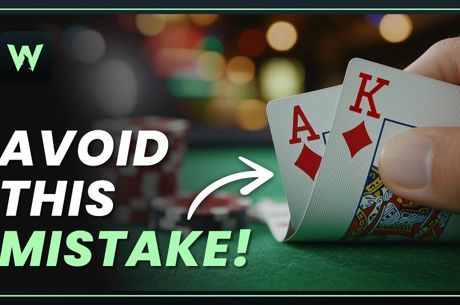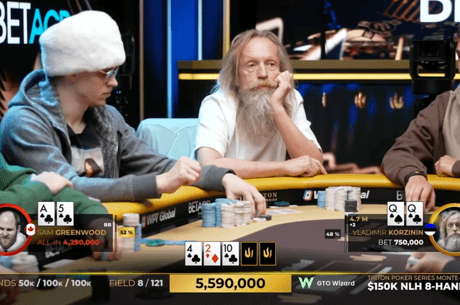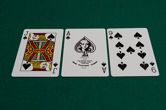Phil Hellmuth Blows Up After Semi-Bluff
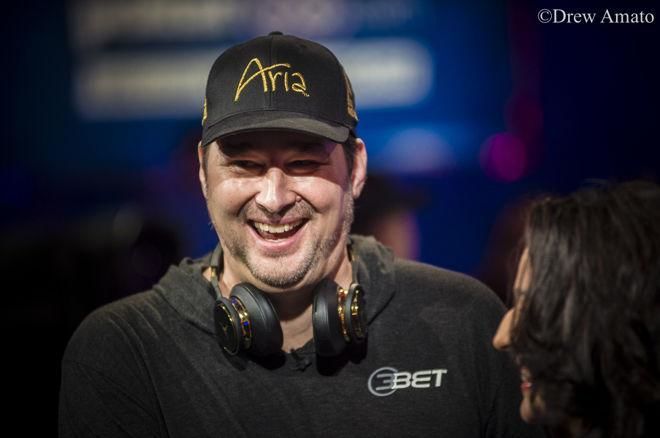
There's no doubt that Phil Hellmuth has had a very successful poker career. He tops the all-time WSOP bracelet list with fifteen, a whopping five more than those tied for second (Doyle Brunson, Phil Ivey, and Johnny Chan).
However the 'Poker Brat' is perhaps better known for his blow-ups and tirades when he loses a pot. Not to spoil the action, but this hand from PokerGO's Poker After Dark is no exception.
That doesn't mean we can't improve our poker strategy from analyzing the hand, so let's dive in!
Preflop
The hand starts with $100/$200 blinds and an UTG straddle to $400 from Alan Keating.
Action folds to Jennifer Tilly on the button who raises to $1,200 with6♠4♠
Phil Hellmuth is next to act in the SB and calls with A♣5♣. The BB folds and Keating decides to squeeze to $4,000 with K♦2♦. Tilly and Hellmuth both call.
Tilly and Keating are both extremely deep, sitting on stacks of $288,000 and $228,000 respectively. Phil Hellmuth has $64,000 behind.
Note: Do you play live poker? Get Upswing Poker's 10 Laws of Live Poker for free to improve your game today.
Preflop Analysis
6♠4♠ is definitely towards the bottom of a good button opening range, but Tilly's raise is completely fine.
Since it is a straddled pot, she does have an extra blind to get through, so she could consider folding it, especially if the blinds 3-bet aggressively.
However, low suited-connector type hands perform especially well in position and deep stacked, and as those are both the case, raising makes sense.
Phil Hellmuth should reraise in his spot from the small blind. Suited wheel aces perform well as preflop bluffs due to their card removal and equity when called. Reraising also gives him the chance to take it down preflop and prevents the other blinds from seeing a cheap flop.
For Alan Keating, K2s makes more sense as a call than a raise. Generally speaking, there are two ways you should construct your 3-betting range in the blinds, linear or polarized.
Not to say that 3-betting K2s here is terrible, and it is probably preferred to folding it, but calling is the best option. K2s just doesn't have the post-flop playability that a hand like A2s has.
If you're thinking "if A2s is a good 3-bet than how bad can K2s really be?" Well, we can check. I plugged both hands into the Poker Equilab calculator against a reasonable button calling range. The results: A2s has 4.5% more equity than K2s!


Not only does A2s have this small but significant equity advantage, it also has a lot more playability with its wheel straight potential.
With the action back to Jennifer Tilly she has a pretty interesting situation. She could conceivably 4-bet this hand as a bluff if she was playing a polarized 4-bet strategy. Calling is definitely fine too as she is extremely deep and has position for the entire hand. Lastly, folding is okay as well as 64s is near the bottom of her open raising range.
So she played it fine, but this is one of those spots where she could have reasonably taken any of her options.
Phil Hellmuth has a close decision as well. He's getting almost 3.5:1 on his call and closes the action with a suited ace which makes calling appealing. On the other hand, he is out of position for the entire hand which means it will be hard for him to get paid off if he does make a strong hand.
That being said, folding is probably better than calling here, but if the call is -EV, it's probably not by much.
Flop
The flop comes 4♣5♦J♥ and the pot is $12,400. Hellmuth checks in the dark, Keating c-bets $7,000, and both Tilly and Hellmuth make the call.
Flop Analysis
Keating's c-bet here is reasonable. He can still represent all of the overpairs, a set of jacks, or AJs. The board is fairly dry and his opponents are going to have to fold a lot of their range.
However, a smaller size is preferred because it accomplishes the same thing. If he bets around $5,000, he's risking less to win the same amount and hands like ace-high or pocket sixes are still put in a tough spot.
That said, if you always 3-bet hands as weak as K2s, and always c-bet the flop, you will find yourself bluffing way too much. With just an overcard and a backdoor flush draw he really didn't flop that much, so he could check at some frequency as well.
Tilly's call is good. A 4 or a 6 improves her to what would almost always be the winning hand, and she can also pick up equity on any 2, 3, 7, or 8. She's certainly not ecstatic about it, but has enough of a piece to call.
Hellmuth is in the same boat as Tilly. He's not stoked, but he closes the action, has second pair top kicker, and a backdoor flush draw. He definitely wants to see at least one more card.
Turn
The turn is the K♣ making the board 4♣5♦J♥K♣ and the pot is $33,400. Hellmuth checks, Alan Keating bets $18,000, Tilly folds, and Hellmuth moves all in for $57,000. Keating makes the call.
Turn Analysis
Keating's bet is reasonable as he hit pretty much the best card in the deck for him. If his opponents know he's over-bluffing preflop and on the flop then he definitely wants to bet when he does make a value hand.
Checking also makes some sense though. Even though he did improve, he could still be behind to a better king, KJs, 54s, or a set of fours or fives. Additionally, sometimes checking with a hand like this protects his checking range and gives him a nice bluff catcher for either this street or the river.
Hellmuth definitely can't fold based on the odds he's getting and his chances to improve. The question is should he fold or raise?
Raising is preferred. There's a lot of value hands he can represent and he has to balance those out with some bluffs. A♣5♣ here is one of his best bluffs as it blocks aces and ace-king and has a ton of equity when called.
Keating probably isn't very happy about it, but he has to make the call vs Hellmuth's shove. If he bets and then folds to a raise in these situations he would be folding significantly too often. If he thinks that Phil Hellmuth is never or very rarely bluffing here then he could find a fold, but (obviously) that's not the case.
River
They decide to run it twice. The first river is K♥ locking up half the pot for Keating.
After losing half the pot Hellmuth still has hope, and gives Alan a sorta-compliment saying he made a good call.
It's all good he made a good call, I have a set half the time. Tomorrow when he makes the call he'll be drawing dead, and he will call.
The second river is the 8♦, so Keating scoops it all. Hellmuth's reaction:
F***ing, I know he's on tilt from the hand before, he makes it 4k before the flop with K2, then he hits a miracle king on the turn, he's so f***ing predictable. I know every hand what Alan has, and he still wins both!
River Analysis
I have to say I like Phil's strategy on the river. If you're going to subtly insult your opponent with a backhanded compliment after losing half, it's always good to balance that range out with a proper, direct insult after losing the entire pot.
This has been a staple of Phil's strategy for years, and it's good to see him sticking to his guns.
Final Thoughts
Even at the highest stakes, with millions of dollars on the tables, mistakes are made almost every hand. The players in your games are likely making even bigger mistakes, and when your opponents make mistakes, there's an opportunity for you to win.
What do you think of Phil's shove on the turn? What about Keating's call? Let us know how you would have played this one differently in the comments below.
Do Not Play Another Hand Without This $7 Mini-Course
With such a low price tag, the $7 Postflop Game Plan is a no-brainer if you want to nail down your fundamentals and build a bigger bankroll.
Sponsor-generated content by Upswing Poker

